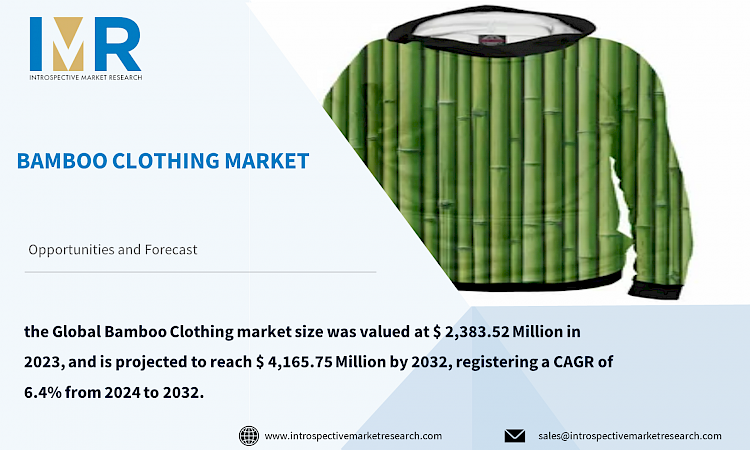
According to a new report published by Introspective Market Research, titled, “Bamboo Clothing Market by Type, Distribution Channel, and End-User: Global Opportunity Analysis and Industry Forecast, 2024–2032,” the Global Bamboo Clothing market size was valued at $ 2,383.52 Million in 2023, and is projected to reach $ 4,165.75 Million by 2032, registering a CAGR of 6.4% from 2024 to 2032.
The Pulp of Bamboo is converted into a textile material called Bamboo fabric, which is used to create a variety of garments, it is popular for its comfort, sustainability, breathability, and moisture-wicking qualities hence it is used in the clothing Industry for making t-shirts, shirts, underwear, socks, leggings, and activewear and also for bedding purpose in making bed sheets, pillowcases, and duvet cover.
It has naturally built temperature-regulating properties, that make it keep cool in summer and warm in winter. Bamboo towels are highly absorbent and quick-drying, which makes them suitable for bath towels, hand towels, and beach towels. Bamboo socks are soft, breathable, and have antibacterial properties, making them odor-resistant and suitable for everyday wear or athletic activities. Undergarments Bamboo underwear and bras are comfortable, moisture-wicking, and hypoallergenic, making them a popular choice for daily wear.
Bamboo has become a favorite material among sustainable fashion brands, one of the key drivers is the Sustainable Fashion trend to Push Bamboo Apparel Sales consumers increasingly prioritize eco-friendly and ethically produced garments. Bamboo is known for its rapid growth and low environmental impact as it requires minimal water, pesticides, and fertilizers compared to other conventionally grown crops, which makes it a more sustainable choice. These properties make bamboo clothing ideal for everyday wear, athletic apparel, and even baby clothing, appealing to a wide range of consumers.
The ongoing innovation in fabric technology presents a significant opportunity for the Global Bamboo Clothing market. This lies in advancing the processing and manufacturing techniques that are used to produce bamboo fabric. Innovations in this area can result in improving the fabric quality, consistency, and durability, addressing concerns such as pilling and shrinkage that may affect the perception of bamboo clothing, developing blended fabrics that combine bamboo with other fibers to create a great performance characteristic, For example, blending bamboo with recycled polyester can result in a fabric with enhanced moisture-wicking properties and increased durability, that ideal for activewear and outdoor apparel.
Global Bamboo Clothing Market, Segmentation
The Bamboo Clothing market is segmented based on Type, Application, Method, and region.
Type:
The T-Shirt segment holds the largest market share, it has high demand in the bamboo clothing market that dominates due to several key factors, making it a preferred choice for consumers seeking comfort, sustainability, and versatility in their wardrobe. Firstly, bamboo t-shirts offer exceptionally wide range for their softness and breathability, providing superior comfort compared to conventional cotton shirts.
The natural properties of bamboo fabric, including its smooth texture and moisture-wicking capabilities, make it ideal for everyday wear in various climates, which gives comfort and keeps fresh throughout the day. This offers versatility in style and design, catering to a wide range of preferences and lifestyles like the basic crew neck, V-neck, or trendy graphic tee, bamboo fabric drapes well and holds the color vibrantly, that allows for diverse fashion options.
Application:
In the Global Bamboo Clothing market, The Retail store segment has the highest demand in the mode of shopping as these retail stores offer a physical shopping experience, that allows the customers to interact directly with the products, feel the fabric, and try on garments, which helps in enhancing their purchasing confidence. This tactile experience is very important for clothing, where fit and feels are significant considerations for consumers.
These stores provide immediate access to the products, that enables the customers to make purchases and take items to home immediately. This convenience is especially appealing in the fast-paced world of fashion, where trends can change rapidly. These stores often benefit from prime locations in high-traffic areas, that draw in a wide range of consumers and maximize exposure for bamboo clothing brands. Additionally, retail stores frequently employ knowledgeable staff who can provide personalized assistance and style to the customers.
Region:
Asia-Pacific countries such as China, India, and Vietnam are major producers of bamboo, which provides a sustainable and abundant source of raw material for bamboo clothing production. These countries have a well-established textile industry with advanced manufacturing capabilities, that allow for efficient and cost-effective production of bamboo clothing. This contributes to a competitive advantage in terms of pricing and supply chain efficiency.
The growing awareness of sustainable and eco-friendly fashion practices is driving consumer demand for bamboo clothing in the Asia-Pacific region. The large and diverse population in Asia-Pacific countries presents a significant consumer base for bamboo clothing, with increasing disposable incomes and changing lifestyle preferences that favor and lead to sustainable and comfortable apparel options.
Some of The Active Market Players Are-
- Liahren (China)
- Cariloha (USA)
- Euphoric Colors (China)
- Wujiang Sigma Textile Co., Ltd. (China)
- Zhuhai Dingfeng Fashion Towel Co., Ltd. (China)
- Qingdao Tian He Xiang Textile Co., Ltd. (China)
- Onno (USA)
- Sichuan Yibin Grace Group (China)
- Boheco (India)
- No Nasties (India)
- Bamboo Tribe (India) and Other Active Players.
Key Industry Developments
- In September 2023, India’s Birla Cellulose launched EcoSoft Bamboo viscose fiber, which is made from a sustainable variant of viscose made from bamboo pulp.
- In Oct 2022, Bamboo Rose partnered with CLO Virtual Fashion and launched a 3D Smart Connector to reduce sample cycles and speed time to market.
Key Findings of the Study
- Global Bamboo Clothing market growth is driven by a Sustainable Fashion trend to Push Bamboo Apparel Sales consumers increasingly prioritize eco-friendly and ethically produced garments.
- Innovation in fabric technology presents a significant opportunity that can result in improving the fabric quality, consistency, and durability, addressing concerns such as pilling and shrinkage, etc.
- Asia-Pacific has a large number of producers and provides a sustainable and abundant source of raw materials for bamboo clothing production.
- The Retail store segment has the highest demand in the mode of shopping as it provides a touch, feel-good nature to the consumers.




